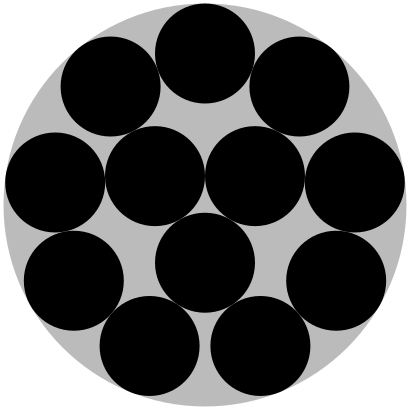Twelve circular muffins fit nicely on a circular plate.

Yes, I know they’re not quite uniform in size. What do you want? My sous-chef is two years old. Also she was not helping but rather running around under the dining room table.
Anyway, this apparently is not the optimal packing – that is, the one that maximizes the ratio (muffin radius)/(plate radius), although it is a piece of the optimal packing in the infinite plane. You could fit slightly larger muffins if you packed them like this:

Image from the Wikipedia article Circle packing in a circle. The proof is due to Ferenc Fodor, The Densest Packing of 12 Congruent Circles in a Circle, Beiträge zur Algebra und Geometrie, Contributions to Algebra and Geometry 41 (2000) ?, 401–409. The radius of the plate is 4.029… times the radius of the muffin. (This is where
is the smallest positive root of
.)
As it turns out, the packing I discovered isn’t all that far off from this constant. Let the radius of the muffin be 1, and draw triangles as below.

The center of the plate is at the center of the packing, which is the center of the red equilateral triangle. If this triangle has side 2, then the distance from its center to any of its vertices is . This is the length of the shortest side of the blue triangle.
The blue triangle therefore has sides of length and
, with an angle of 150 degrees between them. The long side of the blue triangle, by the law of cosines, is given by
The distance from the center to the edge of the plate is then $latex\sqrt{28/3} + 1$, the length of the long side of the blue triangle plus the green line segment which is a single muffin radius. If you’re working this out in your head while watching the aforementioned sous-chef run around at the park, though, you wonder about the numerical value of this constant and think maybe you shouldn’t pull out your phone-calculator. Fortunately it’s easy to work out approximately: , and remembering
for small
this is very close to $3 (1 + 1/54) = 3 + 1/18 \approx 3.055$. So the radius of the (idealized) plate is about
times the radius of the (idealized) muffin, not all that far off from the
due to Fodor.
